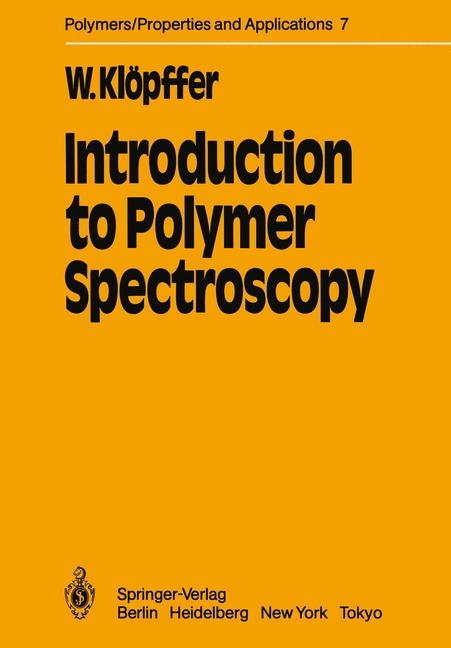Introduction to Polymer Spectroscopy
Springer Berlin (Verlag)
978-3-540-12850-2 (ISBN)
- Titel ist leider vergriffen;
keine Neuauflage - Artikel merken
A. General Introduction.- 1 Introduction.- 1.1 Definition of Polymer Spectroscopy.- 1.2 Information Obtained by Polymer Spectroscopy.- 1.3 Spectral Range.- 1.4 Remarks on the Choice of Examples for Applications.- 1.5 Bibliographic Notes.- References.- B. Electronic Spectroscopy.- 2 ESCA in Polymer Spectroscopy.- 2.1 Principle of the Method.- 2.2 The ESCA Spectrometer.- 2.3 Main Features of ESCA Spectra.- 2.4 Applications of Core-Electron Spectra.- 2.4.1 The Chemical Shift.- 2.4.2 Bulk and Surface Analysis.- 2.4.3 Examples of Bulk Analysis.- 2.4.4 Examples of Surface Analysis.- 2.5 ESCA Spectrum of Valence Electrons.- 2.5.1 Energy Bands.- 2.5.2 Energy Bands in Polymers.- 2.5.3 The Zero-Level Problem in ESCA Studies of Valence Bands.- 2.5.4 Examples of Valence Band Studies Using ESCA.- 2.6 Résumé of ESCA in Polymer Spectroscopy.- References.- 3 Absorption Spectroscopy in the Ultraviolet and Visible Regions.- 3.1 The far Ultraviolet (fUV).- 3.2 Absorption Spectroscopy in the Near Ultraviolet and Visible Regions.- 3.2.1 Spectral Region and Characteristic Transitions.- 3.2.2 Basic Principles of nUV/VIS Absorption Spectroscopy.- 3.2.2.1 Electronic Vibronic Spectra.- 3.2.2.2 Energy Level Diagrams.- 3.2.2.3 Intensity of Absorption Bands.- 3.2.2.4 The Franck-Condon Principle.- 3.2.3 Application of Lambert-Beer’s Law to Polymers.- 3.2.4 UV-Absorbing Polymers.- 3.2.5 Hypochromy in Polymers.- 3.2.6 Absorption by Molecules dissolved in Solid Polymers.- 3.3 Résumé of nUV/VIS-Absorption Spectroscopy.- References.- 4 Fluorescence- and Phosphorescence Spectroscopy of Polymers.- 4.1 Radiative and Radiationless Transitions.- 4.1.1 The Jablonski Diagram.- 4.1.2 Fluorescence.- 4.1.3 Internal Conversion and Inter-System Crossing.- 4.1.4 Phosphorescence.- 4.2 Experimental.- 4.3 Quantum efficiency, decay time and rate constants.- 4.4 Fluorescence in Polymers.- 4.4.1 Isolated and Crowded Fluorescent Groups.- 4.4.2 Fluorescence from Isolated Chromophores.- 4.4.3 Energy Transfer between Isolates Groups or Dissolved Molecules.- 4.4.4 Singlet Excitons.- 4.4.5 Excimer Fluorescence as a Probe in Polymer Studies.- 4.5 Phosphorescence in Polymers.- 4.5.1 The Phosphorescent Triplet State.- 4.5.2 Isolated Phosphorescent Groups.- 4.5.3 Triplet Excitons in Polymers.- 4.6 Résumé of Fluorescence and Phosphorescence Spectroscopy.- References.- C. Vibrational Spectroscopy.- 5 Vibrations.- 5.1 Introduction.- 5.2 The Harmonic Oscillator.- 5.3 Molecular Vibrations as Quantum Phenomena.- 5.4 General Remarks on the Interpretation of Vibrational Spectra.- 5.5 Symmetry and Fundamental Vibrations of One-dimensional Chain Molecules.- 5.6 Phonons.- References.- 6 Raman Spectroscopy.- 6.2 The Smekal-Raman Effect.- 6.3 Experimental.- 6.4 Examples of Laser-Raman Spectra of Synthetic Polymers.- 6.5 The Accordion Vibration.- 6.6 Resonance Raman Scattering.- 6.7 Résumé of Raman Spectroscopy of Polymers.- References.- 7 Infrared Spectroscopy of Polymers.- 7.1 Introduction.- 7.2 Absorption of Infrared Radiation.- 7.3 Experimental.- 7.3.1 IR-Absorption.- 7.3.2 IR Reflection and Emission.- 7.4 Interpretation of Polymer mIR Spectra.- 7.4.1 Empirical IR Spectroscopy.- 7.4.2 Examples of mIR Spectra of Linear Polymers.- 7.4.2.1 Poly(methylmethacrylate).- 7.4.2.2 Poly(isobutene) and amorphous polypropylene.- 7.4.2.3. Poly(vinylalcohol).- 7.4.2.4 Poly(acrylonitrile).- 7.4.2.5 Poly(caprolactam).- 7.4.3 Tacticity and Conformation in mIR Spectra.- 7.5 Applications of mIR Spectroscopy.- 7.5.1 General.- 7.5.2 Copolymers.- 7.5.3 Molar Mass.- 7.5.4 Branching.- 7.5.5 Carbon Double Bonds.- 7.5.6 Oxidation Processes.- 7.5.7 Corona and Plasma Treatment of Polymer Surfaces.- 7.5.8 Dissociation of Polymeric Acids and Other polymer-IR Studies.- 7.6 Résumé of mIR.- 7.7 Far-Infrared Spectroscopy of Polymers.- 7.7.1 Introduction.- 7.7.2 Chemical Applications.- 7.7.3 Phonons in fIR Spectra of Polymers.- 7.7.4 Inelastic Neutron Scattering (INS).- 7.7.5 Résumé of fIR + INS.- References.- D. Spin-Resonance Spectroscopy.- 8 Principles of Spin-Resonance Spectroscopy.- 8.1 Introduction.- 8.2 The Spin of Elementary Particles.- 8.3 Resonance Absorption.- 8.4 Spin-Resonance in Polymers.- References.- 9 Electron-Spin-Resonance (ESR) Spectroscopy of Polymers.- 9.1 General Characteristics of ESR Spectra.- 9.2 Experimental.- 9.3 Survey of Polymer-Specific Applications of ESR Spectroscopy.- 9.4 Polymerisation Studies by Means of ESR.- 9.5 Mechanically Formed Polymer Radicals.- 9.6 ESR of Radicals Formed by Radiation.- 9.7 Triplet States.- 9.8 Spin-Labels.- 9.9 Résumé.- References.- 10 Nuclear Magnetic Resonance (NMR) Spectroscopy of Polymers.- 10.1 The Origine of NMR Spectra.- 10.2 Experimental.- 10.3 High-Resolution 1H-NMR of Polymers.- 10.3.1 Applications.- 10.3.2 Tacticity Analysis.- 10.4 Broad-line NMR.- 10.5 Spin-Relaxation Times.- 10.6 Chemically Induced Dynamic Nuclear Spin Polarisation (CIDNP)...- 10.7 Résumé of 1H-NMR Spectroscopy.- 10.8 Polymer NMR Spectroscopy of 13C and Other Nuclei.- 10.8.1 Experimental.- 10.8.2 Solid Polymer 13C-NMR Spectroscopy.- 10.8.3 High Resolution 13C-NMR Spectroscopy of Polymer Solution.- 10.8.4 Other Nuclei.- 10.9 Résumé.- References.- E. Conclusion and Appendices.- Conclusion.- Appendix 1: Table of Polymers.- Appendix 2: List of Abbreviations.- Appendix 3: List of Elementary Constants Used in This Book.
| Erscheint lt. Verlag | 5.12.2012 |
|---|---|
| Reihe/Serie | Polymers - Properties and Applications |
| Zusatzinfo | XII, 192 p. |
| Verlagsort | Berlin |
| Sprache | englisch |
| Gewicht | 480 g |
| Themenwelt | Naturwissenschaften ► Chemie ► Organische Chemie |
| Naturwissenschaften ► Physik / Astronomie ► Atom- / Kern- / Molekularphysik | |
| Technik ► Maschinenbau | |
| Schlagworte | Molecule • particles • Polymer • scattering • Spectra • spectroscopy • Spektroskopie • Tacticity |
| ISBN-10 | 3-540-12850-6 / 3540128506 |
| ISBN-13 | 978-3-540-12850-2 / 9783540128502 |
| Zustand | Neuware |
| Haben Sie eine Frage zum Produkt? |
aus dem Bereich




